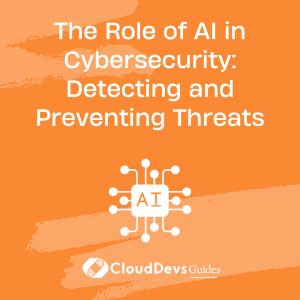The Role of AI in Cybersecurity: Detecting and Preventing Threats
In an increasingly digital world, the need for robust cybersecurity measures has never been more critical. With cyber threats becoming more sophisticated and prevalent, traditional methods of defense are no longer sufficient. This is where Artificial Intelligence (AI) steps in as a game-changer. AI’s ability to analyze vast amounts of data, identify patterns, and adapt to evolving threats makes it an invaluable tool in the fight against cyber attacks. In this article, we’ll delve into the pivotal role of AI in cybersecurity, exploring its applications in detecting and preventing threats.

1. Understanding the Cybersecurity Landscape
The modern cybersecurity landscape is rife with a multitude of threats, ranging from malware and phishing attacks to ransomware and zero-day exploits. These threats exploit vulnerabilities in software, networks, and even human behavior. As organizations and individuals continue to store sensitive data and conduct critical operations online, the stakes have never been higher.
2. The Limitations of Traditional Approaches
Traditional cybersecurity approaches, while effective to some extent, often fall short in dealing with the dynamic nature of contemporary threats. Signature-based detection, where known patterns of attacks are matched against incoming data, can easily miss previously unseen attacks. Additionally, rule-based systems struggle to adapt to new attack vectors, leaving organizations vulnerable to zero-day exploits.
3. Enter Artificial Intelligence
AI brings a new level of sophistication to the realm of cybersecurity. Machine Learning (ML), a subset of AI, equips systems with the ability to learn from data and improve their performance over time. This adaptability is crucial in tackling emerging threats. Let’s explore some key areas where AI is making a significant impact:
3.1. Threat Detection
AI-driven threat detection systems excel at identifying anomalous behavior. By establishing a baseline of normal activities, these systems can flag deviations that might indicate a cyber attack. This is particularly valuable in detecting insider threats, where malicious actions may be subtle and difficult to spot. Let’s take a look at a simplified example of anomaly detection using Python and scikit-learn:
python from sklearn.ensemble import IsolationForest # Sample data (features extracted from network traffic) data = [...] # Create the anomaly detection model model = IsolationForest(contamination=0.05) # Adjust contamination based on use case # Train the model model.fit(data) # Predict anomalies predictions = model.predict(data) # Identify flagged instances anomalies = data[predictions == -1]
3.2. Behavioral Analysis
AI can analyze user behavior to identify suspicious activities. By understanding how users typically interact with systems, AI algorithms can spot deviations that might indicate unauthorized access. This is crucial in preventing account takeovers and unauthorized data access. Consider the following behavioral analysis process:
- Collect and profile user behavior data.
- Apply clustering algorithms to group similar behavior patterns.
- Monitor for deviations from established patterns and trigger alerts.
3.3. Vulnerability Management
AI can assist in identifying and mitigating vulnerabilities in software and systems. By analyzing code and configurations, AI algorithms can pinpoint potential weaknesses that could be exploited by attackers. This proactive approach to vulnerability management enhances an organization’s overall security posture.
3.4. Malware Detection
Malware is a prevalent threat in the cybersecurity landscape. Traditional signature-based antivirus solutions struggle to keep up with the rapid evolution of malware variants. AI-powered malware detection leverages ML models trained on vast datasets to recognize patterns indicative of malicious software.
4. Real-world Examples
AI’s impact on cybersecurity is not theoretical; it’s evident in real-world applications. Let’s explore a couple of examples:
4.1. IBM Watson for Cyber Security
IBM Watson for Cyber Security utilizes AI to analyze vast amounts of unstructured data, including blogs, articles, and research papers. By continuously learning from new information, Watson can identify emerging threats and provide insights to security professionals. This proactive approach enables organizations to stay ahead of potential risks.
4.2. Darktrace’s Enterprise Immune System
Darktrace’s Enterprise Immune System employs AI to create a self-learning model of an organization’s network. It understands ‘normal’ behavior and can swiftly detect deviations that might indicate a breach. The system’s ability to adapt to changing network dynamics makes it particularly effective in identifying novel threats.
5. Ethical Considerations and Challenges
While AI offers remarkable capabilities in enhancing cybersecurity, it also introduces ethical considerations and challenges. The use of AI in cybersecurity raises questions about privacy, accountability, and potential biases in algorithms. Striking the right balance between security and individual rights remains a complex issue that requires careful consideration.
6. The Future of AI in Cybersecurity
As cyber threats continue to evolve, AI’s role in cybersecurity will undoubtedly expand. Predictive analytics, where AI forecasts potential threats based on historical data, and autonomous response systems, where AI takes immediate actions to mitigate threats, represent the future of AI-driven cybersecurity.
Conclusion
In a world where cyber threats are a constant reality, AI emerges as a powerful ally in defending against malicious activities. Its ability to adapt, learn, and identify subtle patterns gives cybersecurity professionals an upper hand in an ever-changing landscape. As technology advances and AI continues to evolve, it’s clear that the partnership between AI and cybersecurity will play an increasingly crucial role in safeguarding our digital world. Through ongoing research, innovation, and ethical considerations, we can harness AI’s potential to build a safer digital future.
By embracing AI’s capabilities, the field of cybersecurity takes a giant leap towards fortifying our digital infrastructure. From detecting anomalies to predicting emerging threats, AI-driven solutions are shaping a more secure online landscape. As we navigate the intricacies of an interconnected world, the fusion of AI and cybersecurity stands as a beacon of defense against the ever-advancing tide of cyber threats.
Table of Contents








